Sisak-Moslavina County
Sisak-Moslavina County (Croatian: Sisačko-moslavačka županija) is a Croatian county in eastern Central Croatia and southwestern Slavonia. It is named after the city of Sisak and the region Moslavina just across the river Sava. According to 2011 census it is inhabited by 172,000 people.
Sisak-Moslavina County Sisačko-moslavačka županija | |
|---|---|
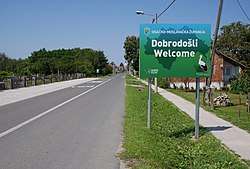 Sign for Sisak-Moslavina County in Hrvatska Dubica | |
 Flag 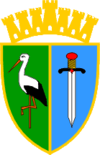 Coat of arms | |
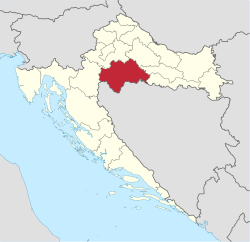 Sisak-Moslavina County within Croatia | |
| Country | Croatia |
| County seat | Sisak |
| Government | |
| • Župan | Ivo Žinić (HDZ) |
| Area | |
| • Total | 4,468 km2 (1,725 sq mi) |
| Population (2011)[2] | |
| • Total | 172,439 |
| • Density | 39/km2 (100/sq mi) |
| Area code | 044 |
| ISO 3166 code | HR-03 |
| HDI (2017) | 0.822[3] Very high · 6th |
| Website | www |
This county contains the ancient Roman city of Siscia—today's Sisak. Siscia was the largest city of the region back then, a Pannonian capital, likely due to its position on the confluence of the Kupa and Sava rivers. The city's patron saint is its first Christian bishop, St. Kvirin, who was tortured and almost killed during Diocletian's persecution of Christians. Legend has it that they tied him to a millstone and threw him into a river, but he freed himself from the weight, escaped and continued to preach his faith.
The town may have lost importance with the fall of one empire, but it recovered it soon enough with the rise of another: Sisak became famous for crucial battles between European armies and the Ottoman Turks. In particular, the battle of 1593 when the Ottoman army first suffered a large defeat. The ban Toma Bakač Erdedi who led the defense in this battle became famous throughout Europe.
Today, Sisak features the largest Croatian metallurgic factory (supported by the University of Zagreb's Faculty of Metallurgy also in the city) and the largest oil refinery. These are coupled with the petrochemical facilities in the nearby town of Kutina, the first recorded mention of which was in 1256 by king Béla IV. Moslavina is probably the most picturesque part of this county, with the natural park Lonjsko polje near the rivers Lonja, Ilova and Pakra.
This county also extends far to the south, bordering Bosnia. In this southern part of the county, one can find the small town of Topusko, which boasts one of the spas typical of Central Croatia, although this one's seniority stands out because it dates back to the neolithic age.
Sisak-Moslavina County borders Karlovac County in the west, Zagreb County in the north, Bjelovar-Bilogora County and Požega-Slavonia County in the northeast, and Brod-Posavina County in the east.
Administrative division
Sisak-Moslavina county is subdivided as follows:
- City of Sisak (county seat)
- Town of Glina
- Town of Hrvatska Kostajnica
- Town of Kutina
- Town of Novska
- Town of Petrinja
- Town of Popovača
- Municipality of Donji Kukuruzari
- Municipality of Dvor
- Municipality of Gvozd
- Municipality of Hrvatska Dubica
- Municipality of Jasenovac
- Municipality of Lekenik
- Municipality of Lipovljani
- Municipality of Majur
- Municipality of Martinska Ves
- Municipality of Sunja
- Municipality of Topusko
- Municipality of Velika Ludina
Demographics
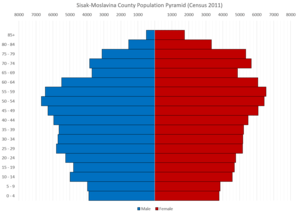
As of the 2011 census, the county had 172,439 residents. The population density is 39 people per km2.
Ethnic Croats form the majority with 82.4% of the population, followed by Serbs at 12.2%.[4]
|
| ||||||||||||||||||||||||||||||||||||||||||||||||||||||
| Source: Naselja i stanovništvo Republike Hrvatske 1857–2001, Croatian Bureau of Statistics, Zagreb, 2005 | |||||||||||||||||||||||||||||||||||||||||||||||||||||||
Population change 1857-2011[5]
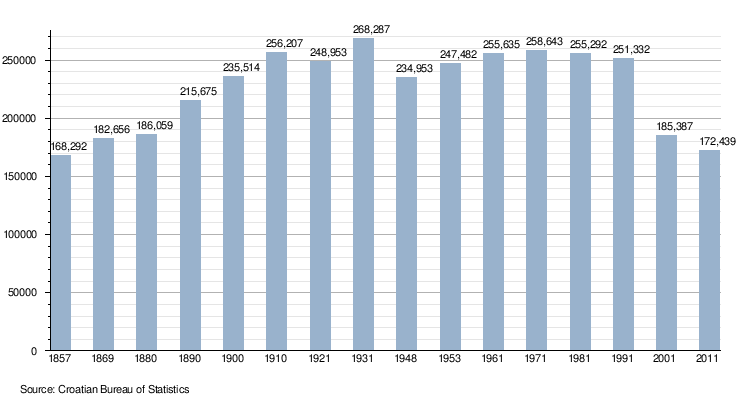
See also
References
- Ostroški, Ljiljana, ed. (December 2015). Statistički ljetopis Republike Hrvatske 2015 [Statistical Yearbook of the Republic of Croatia 2015] (PDF). Statistical Yearbook of the Republic of Croatia (in Croatian and English). 47. Zagreb: Croatian Bureau of Statistics. p. 62. ISSN 1333-3305. Retrieved 27 December 2015.
- "Population by Age and Sex, by Settlements, 2011 Census: County of Sisak-Moslavina". Census of Population, Households and Dwellings 2011. Zagreb: Croatian Bureau of Statistics. December 2012.
- "Sub-national HDI - Area Database - Global Data Lab". hdi.globaldatalab.org. Retrieved 2018-09-13.
- "Population by Ethnicity, by Towns/Municipalities, 2011 Census: County of Sisak-Moslavina". Census of Population, Households and Dwellings 2011. Zagreb: Croatian Bureau of Statistics. December 2012.
- Naselja i stanovništvo Republike Hrvatske 1857.-2001., www.dzs.hr
External links
| Wikimedia Commons has media related to Sisak-Moslavina County. |
- Official website
